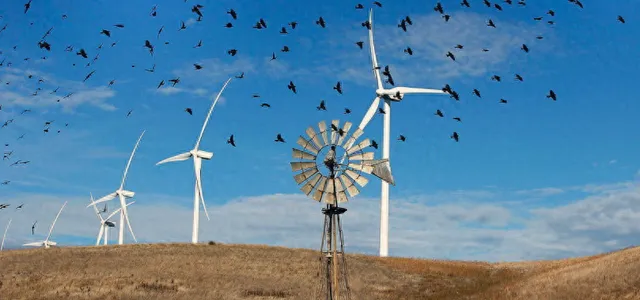原文標題 :
Sharing the skies
Wind turbines are friendlier to birds than oil-and-gas drilling
Contrary to what opponents of wind farms fear
共享天空
風力渦輪機比石油天然氣鉆井對鳥類更友好
與風電場反對者所擔心的正好相反
[Paragraph 1]
BIRDERS GET nervous when they see landscapes covered in wind turbines.
當觀鳥者看到風景區被風力渦輪機覆蓋時,他們會感到緊張。
When the wind gets going, their blades can spin at well over 200km per hour. It is easy to imagine careless birds getting chopped to bits.
風起時,風力渦輪機葉片的旋轉速度遠超200公裏/小時。不難想象,鳥兒一不小心就會被切成碎片。
Campaigners often point to the possibility when opposing the building of new wind farms.
活動人士在反對建造新的風電場時,經常強調這種可能性。

[Paragraph 2]
No one doubts that wind turbines do indeed kill at least some birds.
當然,風力渦輪機確實造成了一些鳥類死亡,這毋庸置疑。
But a new analysis of American data, published in Environmental Science & Technology, suggests the numbers are negligible, and have little impact on bird populations.
但【環境科學與技術】期刊上發表的美國最新數據分析表明,這些死亡鳥類數碼可以忽略不計,對鳥類族群幾乎沒有影響。
[Paragraph 3]
Wind power has expanded dramatically in America over the past 20 years, from 2.6 gigawatts of installed capacity on land in 2000 to 122 gigawatts in 2020.
過去20年來,美國的風力發電量急劇增長,陸地裝機容量從2000年的2.6吉瓦增加到2020年的122吉瓦。
Many studies have analysed the effects in specific locations or on specific bird species. But few have looked at the effects on wildlife at the population level.
許多研究分析了特定地點或特定鳥類的影響。但很少有人研究對野生動物族群水平的影響。
Enter Erik Katovich, an economist at the University of Geneva. Dr Katovich made use of the Christmas Bird Count, a citizen-science project run by the National Audubon Society, an American non-profit outfit.
日內瓦大學的經濟學家艾歷·卡托維奇在這方面進行了研究。卡托維奇博士利用了聖誕節數鳥活動的數據,這是一個由美國非營利機構國家「奧杜邦協會」營運的公眾科學專案。
Volunteers count birds they spot over Christmas, and the society compiles the numbers. Its records stretch back over a century.
誌願者在聖誕節期間統計他們觀察到的鳥類數量,奧杜邦協會負責匯總這些數據。該專案記錄可追溯到100多年前。
[Paragraph 4]
Dr Katovich assumed, reasonably, that if wind turbines harmed bird populations, then the numbers seen in the Christmas Bird Count would drop in places where new turbines had been built.
卡托維奇博士進行了合理的假設:如果風力渦輪機對鳥類族群造成危害,那麽在建造新渦輪機的地方,聖誕節數鳥活動中看到的鳥類數量就會下降。
He combined bird population and species maps with the locations and construction dates of all wind turbines in the United States, with the exceptions of Alaska and Hawaii, between 2000 and 2020.
他將2000-2020年間美國所有風力渦輪機(阿拉斯加和夏威夷除外)的位置和建設日期與鳥類族群和物種分布圖結合起來。
He found that building turbines had no
discernible
effect on bird populations.
他發現建造渦輪機對鳥類數量沒有明顯影響。
That reassuring finding held even when he looked specifically at large birds like
hawks
,
vultures
and eagles that many people believe are particularly vulnerable to being struck.
甚至當他專門觀察鷹隼、禿鷲和老鷹等易受到撞擊的大型鳥類時,這一令人欣慰的發現仍然成立。
[Paragraph 5]
But Dr Katovich did not confine his analysis to wind power alone. He also examined oil-and-gas extraction.
但是,卡托維奇博士並沒有把他的分析僅僅局限於風力發電。他還研究了油氣開采。
Like wind power, this has boomed in America over the past couple of decades, with the rise of
shale
gas produced by
hydraulic
fracturing
, or fracking, of rocks.
與風力發電一樣,過去幾十年來,隨著水力壓裂或巖石壓裂技術產生的頁巖氣產量增加,美國的油氣開采也蓬勃發展。
Production rose from 37m cubic metres in 2007 to 740m cubic metres in 2020.
產量從2007年的3700萬立方米增加到2020年的7.4億立方米。
[Paragraph 6]
Comparing bird populations to the locations of new gas wells revealed an average 15% drop in bird numbers when new wells were drilled, probably due to a combination of noise, air pollution and the disturbance of rivers and ponds that many birds rely upon.
將鳥類的數量與新天然氣井的位置進行比較後發現,鉆探新井時鳥類數量平均下降 15%,這可能是由於噪音、空氣汙染以及許多鳥類賴以生存的河流和池塘受到幹擾等綜合因素造成的。
When drilling happened in places designated by the National Audubon Society as 「important bird areas」, bird numbers instead dropped by 25%.
當鉆探發生在國家奧杜邦協會指定的「重點鳥類區域」時,鳥類數量反而下降了 25%。
Such places are typically migration hubs, feeding grounds or breeding locations.
這些地方通常是鳥類的遷徙中心、覓食地或繁殖地。
[Paragraph 7]
Wind power, in other words, not only produces far less planet-heating carbon dioxide and methane than do fossil fuels. It appears to be significantly less damaging to wildlife, too.
換句話說,風力發電不僅比化石燃料產生更少使地球變暖的二氧化碳和甲烷,而且對野生動物的傷害似乎也小得多。
Yet that is not the impression you would get from reading the news.
然而,如果你讀新聞,你可能會得到相反的印象。
Dr Katovich found 173 stories in major American news outlets reporting the supposed negative effects that wind turbines had on birds in 2020, compared with only 46 stories discussing the effects of oil-and-gas wells.
卡托維奇博士發現,2020年美國主流新聞媒體有173篇關於風力發電機對鳥類產生負面影響的報道,而只有46篇報道討論了石油和天然氣井對鳥類的影響。
Wind turbines might look dramatic. But their effect on birds is not.
風力渦輪機可能看起來很引人註目。但它們對鳥類的影響並不大。
(恭喜讀完,本篇英語詞匯量524左右)
原文出自:2024年1月13日【The Economist】Science & technology版塊
精讀筆記來源於:自由英語之路
本文轉譯整理: Irene
本文編輯校對: Irene
僅供個人英語學習交流使用。
【補充資料】
(來自於網絡)
吉瓦是功率單位,符號為GW。1吉瓦=10億瓦=1 000兆瓦=1百萬千瓦。
聖誕節數鳥活動始於1900 年,是北美執行時間最長的公民科學專案。每年在西半球有2000多個地方的人們都會參與其中,幫助收集有關鳥類的資訊,了解氣候變遷如何影響生物多樣性。數千名誌願者參與收集的這些數據構成了世界上最大的野生動物調查數據庫之一 ,保護生物學家、環境規劃師和自然學家們利用這些數據來評估鳥類的族群趨勢和分布。
【重點句子】
(3個)
Many studies have analysed the effects in specific locations or on specific bird species. But few have looked at the effects on wildlife at the population level.
許多研究分析了特定地點或特定鳥類的影響。但很少有人研究對野生動物族群水平的影響。
He found that building turbines had no discernible effect on bird populations.
他發現建造渦輪機對鳥類數量沒有明顯影響。
Wind power, in other words, not only produces far less planet-heating carbon dioxide and methane than do fossil fuels. It appears to be significantly less damaging to wildlife, too.
換句話說,風力發電不僅比化石燃料產生更少使地球變暖的二氧化碳和甲烷,而且對野生動物的傷害似乎也小得多。

自由英語之路











